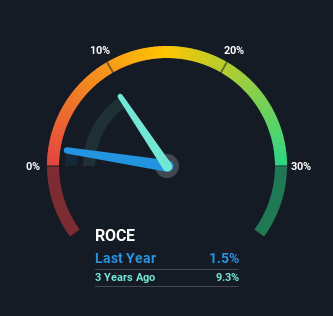Be Wary Of Tibet Water Resources (HKG:1115) And Its Returns On Capital

If we're looking to avoid a business that is in decline, what are the trends that can warn us ahead of time? When we see a declining return on capital employed (ROCE) in conjunction with a declining base of capital employed, that's often how a mature business shows signs of aging. This indicates the company is producing less profit from its investments and its total assets are decreasing. So after we looked into Tibet Water Resources (HKG:1115), the trends above didn't look too great.
Understanding Return On Capital Employed (ROCE)
If you haven't worked with ROCE before, it measures the 'return' (pre-tax profit) a company generates from capital employed in its business. To calculate this metric for Tibet Water Resources, this is the formula:
Return on Capital Employed = Earnings Before Interest and Tax (EBIT) ÷ (Total Assets - Current Liabilities)
0.015 = CN¥48m ÷ (CN¥4.2b - CN¥883m) (Based on the trailing twelve months to June 2021).
Thus, Tibet Water Resources has an ROCE of 1.5%. Ultimately, that's a low return and it under-performs the Beverage industry average of 10%.
See our latest analysis for Tibet Water Resources

While the past is not representative of the future, it can be helpful to know how a company has performed historically, which is why we have this chart above. If you want to delve into the historical earnings, revenue and cash flow of Tibet Water Resources, check out these free graphs here.
The Trend Of ROCE
We are a bit worried about the trend of returns on capital at Tibet Water Resources. About five years ago, returns on capital were 10.0%, however they're now substantially lower than that as we saw above. On top of that, it's worth noting that the amount of capital employed within the business has remained relatively steady. This combination can be indicative of a mature business that still has areas to deploy capital, but the returns received aren't as high due potentially to new competition or smaller margins. So because these trends aren't typically conducive to creating a multi-bagger, we wouldn't hold our breath on Tibet Water Resources becoming one if things continue as they have.
What We Can Learn From Tibet Water Resources' ROCE
In summary, it's unfortunate that Tibet Water Resources is generating lower returns from the same amount of capital. This could explain why the stock has sunk a total of 85% in the last five years. That being the case, unless the underlying trends revert to a more positive trajectory, we'd consider looking elsewhere.
Tibet Water Resources does have some risks, we noticed 2 warning signs (and 1 which is significant) we think you should know about.
While Tibet Water Resources may not currently earn the highest returns, we've compiled a list of companies that currently earn more than 25% return on equity. Check out this free list here.
Valuation is complex, but we're here to simplify it.
Discover if Tibet Water Resources might be undervalued or overvalued with our detailed analysis, featuring fair value estimates, potential risks, dividends, insider trades, and its financial condition.
Access Free AnalysisHave feedback on this article? Concerned about the content? Get in touch with us directly. Alternatively, email editorial-team (at) simplywallst.com.
This article by Simply Wall St is general in nature. We provide commentary based on historical data and analyst forecasts only using an unbiased methodology and our articles are not intended to be financial advice. It does not constitute a recommendation to buy or sell any stock, and does not take account of your objectives, or your financial situation. We aim to bring you long-term focused analysis driven by fundamental data. Note that our analysis may not factor in the latest price-sensitive company announcements or qualitative material. Simply Wall St has no position in any stocks mentioned.
About SEHK:1115
Tibet Water Resources
An investment holding company, engages in the manufacture of beverages in the People’s Republic of China.
Adequate balance sheet with weak fundamentals.
Market Insights
Community Narratives



